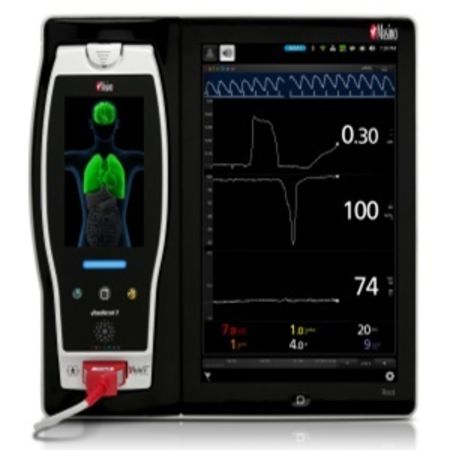ORI, Masimo’s 11th rainbow® parameter2, which is available outside of the United States, is a relative index of the PaO2 operating in the range of 100 to 200 mm Hg. ORI can provide a calculated oxygen reserve index that may add to information from pulse oximetry when oxygen saturation (SpO2) is >98%. ORI is intended to supplement, not replace, SpO2 monitoring and PaO2 measurements.
In the study, published in the journal Anesthesia & Analgesia and conducted at Loma Linda University, Dr. Applegate and colleagues studied 106 patients in which arterial catheterization and intraoperative arterial blood gas analysis were planned during surgery. Multiwavelength Pulse CO-oximetry data from multiple sensors on each patient were continuously collected (Masimo Radical-7® with Root®). A retrospective analysis was then conducted to evaluate the ORI to PaO2 relationship.
Regression analysis showed a positive ORI to PaO2 relationship for PaO2 values up to 240 mm Hg (r2 = 0.536), but not for PaO2 over 240 mm Hg (r2 = 0.0016). Measured PaO2 was ≥100 mm Hg for all ORI values over 0.24, and when ORI was higher than 0.55, the measured PaO2 was ≥150 mm Hg in 96.6% of samples.
The investigators concluded, “This study suggests that intraoperative ORI can distinguish PaO2 between 100 and 150 mm Hg when SpO2 is >98%. Decreases in ORI to near 0.24 may provide advance indication of falling PaO2 when SpO2 is still >98% and above the PaO2 level at which SaO2 [arterial oxygen saturation] declines rapidly. Usefulness of ORI >0.24 to distinguish PaO2 ≥100 mm Hg and ORI >0.55 to distinguish PaO2 ≥150 mm Hg should be tested prospectively in a range of clinical settings.” Additionally, the investigators noted that “the clinical utility of interventions based on continuous ORI monitoring should also be studied prospectively,” and that other clinical or feasibility limitations may not have been identified. The authors also noted that the study was limited by a small number of subjects and samples with PaO2 values <100 mm Hg, and that the study results did not apply to intensive care settings.
The Loma Linda University School of Medicine, Department of Anesthesiology received a grant from Masimo to support the data collection for this study.
Radical-7 with Root has a CE Mark with the ORI parameter. ORI has not received FDA 510(k) clearance and is not available for sale in the United States.
Source & Image Credit: Masimo
1. Applegate RL 2nd, Dorotta IL, Wells B, Juma D, Applegate PM. The Relationship Between Oxygen Reserve Index and Arterial Partial Pressure of Oxygen During Surgery. Anesth Analg. 2016 Mar 22. [Epub ahead of print] PubMed PMID: 27007078.
2. The 11 rainbow® parameters include: 1) oxygen saturation (SpO2); 2) Pulse rate; 3) Perfusion index (PI); 4) Pleth Variability Index (PVI®); 5) Respiration Rate from the pleth (RRp®); 6) Total hemoglobin (SpHb®); 7) Oxygen Content (SpOC™); 8) Carboxyhemoglobin (SpCO®); 9) Methemoglobin (SpMet®); 10) Fractional oxygen saturation (SpfO2®); 11) Oxygen Reserve Index (ORI™)



























